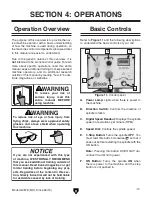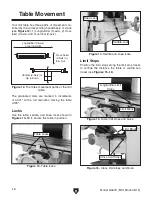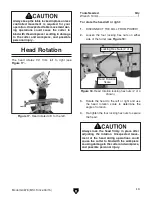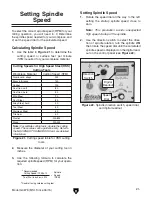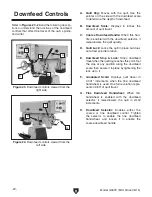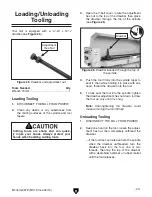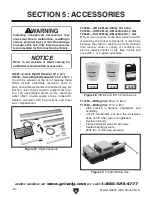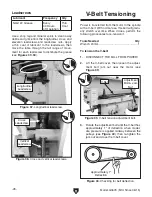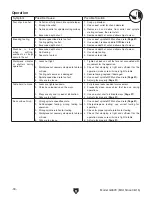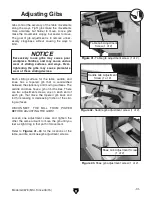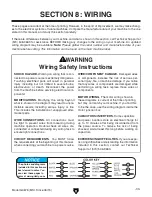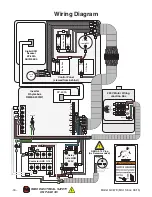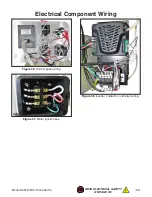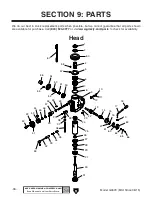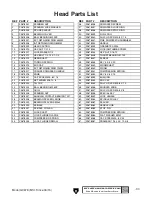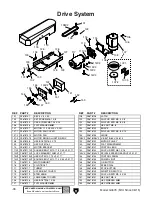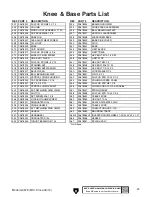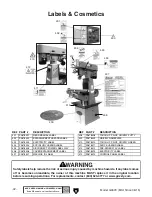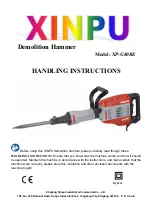
Model G0678 (Mfd. Since 06/15)
-29-
Motor & Electrical
Symptom
Possible Cause
Possible Solution
Machine does not
start or a breaker
trips.
1. Stop button is pushed in or is at fault.
2. ON button is at fault.
3. Plug/receptacle is at fault or wired
incorrectly.
4. Power supply is switched
OFF or is at
fault.
5. Motor connection wired incorrectly.
6. Motor windings or motor is at fault.
1. Turn the stop button clockwise until it pops out;
replace if faulty.
2. Replace faulty ON button.
3. Test for good contacts; correct the wiring.
4. Ensure hot lines have correct voltage on all legs and
main power supply is switched
ON.
5. Correct motor wiring connections (
Page 34).
6. Replace motor.
Machine stalls or is
overloaded.
1. Machine is undersized for the task.
2. Workpiece alignment is poor.
3. Dull or incorrect cutting tool.
4. Motor connection is wired incorrectly.
5. Plug/receptacle is at fault.
6. Pulley/sprocket slipping on shaft.
7. Motor bearings are at fault.
8. Motor has overheated.
9. Motor is at fault.
1. Use smaller sharp tooling; reduce the feed rate;
reduce the spindle RPM; use coolant.
2. Eliminate workpiece binding; use vise or clamps as
required for workpiece alignment control.
3. Use sharp and correct cutting tool for the operation.
4. Correct motor wiring connections (
Page 34).
5. Test for good contacts; correct the wiring.
6. Replace loose pulley/shaft.
7. Test by rotating shaft; rotational grinding/loose shaft
requires bearing replacement.
8. Clean off motor, let cool, and reduce workload.
9. Test and repair or replace.
Machine
has
vibration or noisy
operation.
1. Tool holder or cutter is at fault.
2. Workpiece alignment is poor.
3. Motor or component is loose.
4. Pulley is loose.
5. Machine is incorrectly mounted or sits
unevenly.
6. Motor fan is rubbing on fan cover.
7. Motor bearings are at fault.
1. Replace out-of-round tool holder; replace/resharpen
cutter; use appropriate feed rate and cutting RPM.
2. Eliminate workpiece binding; use vise or clamps as
required for workpiece alignment control.
3. Inspect/replace stripped or damaged bolts/nuts, and
re-tighten with thread locking fluid.
4. Realign/replace shaft, pulley, setscrew, and key as
required.
5. Tighten/replace mounting bolts in floor; relocate/
shim machine.
6. Replace dented fan cover or fan.
7. Test by rotating shaft; rotational grinding/loose shaft
requires bearing replacement.
Review the troubleshooting procedures in this section if a problem develops with your machine. If you need
replacement parts or additional help with a procedure, call our Technical Support.
Note: Please gather the
serial number and manufacture date of your machine before calling.
SECTION 7: SERVICE
Troubleshooting



